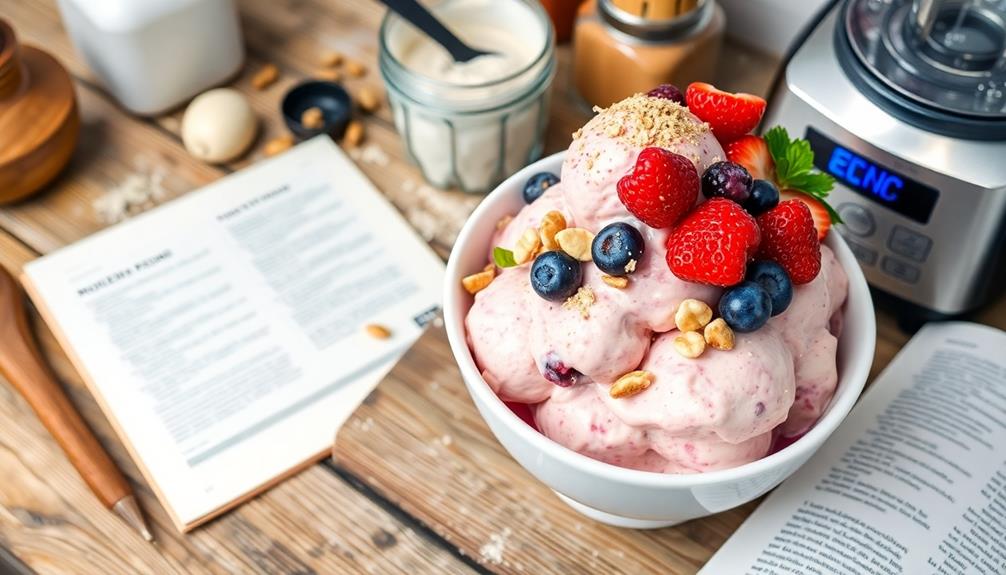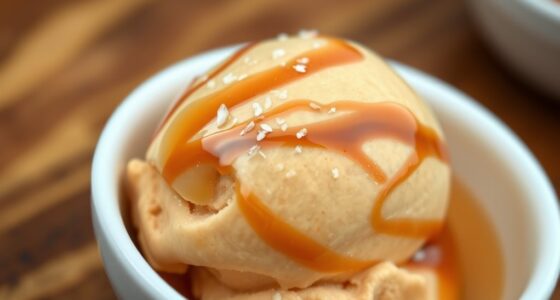You can definitely enjoy tasty low-sugar ice cream that's perfect for a diabetic diet. By using sugar substitutes like stevia or erythritol and rich bases like coconut milk or heavy cream, you can create creamy desserts with under 5 grams of sugar per serving. Try flavoring your ice cream with vanilla extract, mint, or berries for extra pizzazz. To make it smooth, be sure to chill your ingredients well and whip them thoroughly. With endless flavor variations and simple preparation steps, you'll be crafting delicious treats in no time. Want to know more about ingredient swaps and serving ideas?
Key Takeaways
- Low-sugar ice cream contains less than 5 grams of sugar per serving, making it safe for diabetics.
- Use sugar alternatives like stevia or erythritol to minimize blood glucose impact while sweetening.
- Rich bases like coconut cream or heavy cream provide healthy fats, enhancing flavor and texture.
- Customize recipes with flavors like mint, fruity options, or peanut butter to suit personal preferences.
- Store in airtight containers and consume within 2-4 weeks for optimal freshness and taste.
Benefits of Low-Sugar Ice Cream
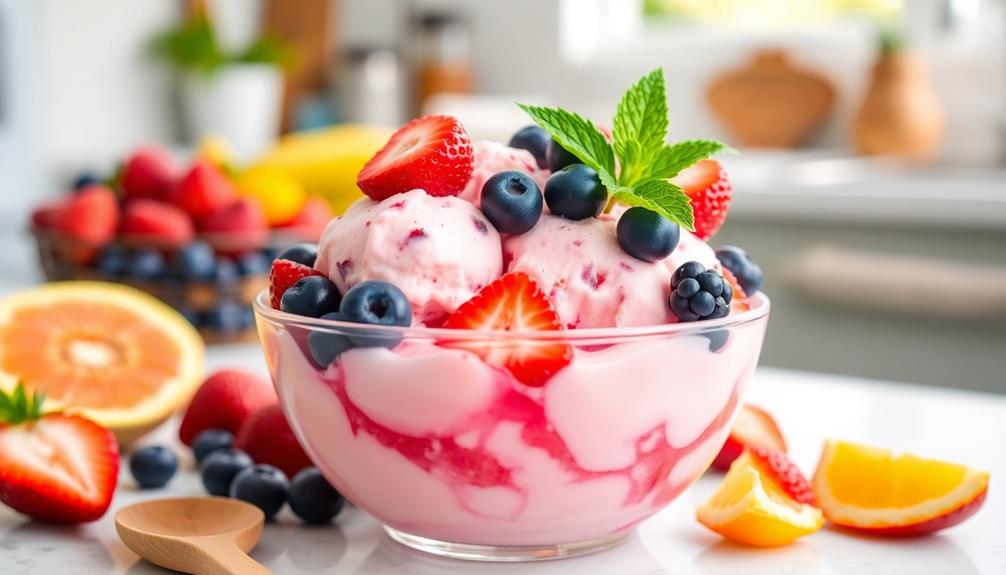
When you choose low-sugar ice cream, you're not just indulging your sweet tooth; you're making a healthier dessert choice. This frozen treat typically contains fewer than 5 grams of sugar per serving, making it a safer option for diabetics who need to manage blood sugar levels. Instead of traditional sugars, low-sugar ice creams often utilize sugar alternatives like stevia or erythritol, which have little impact on blood glucose.
Another advantage is the lower calorie count; many recipes offer around 330 calories per serving. This feature can help you enjoy dessert without worrying about weight gain.
Plus, low-sugar ice cream can be rich in healthy fats, especially when made with coconut cream, promoting satiety and curbing the urge to overeat.
To boost the nutritional value even further, you can incorporate fiber-rich ingredients like nuts or berries. These additions not only enhance flavor and texture but also help stabilize blood sugar levels.
Key Ingredients for Recipes
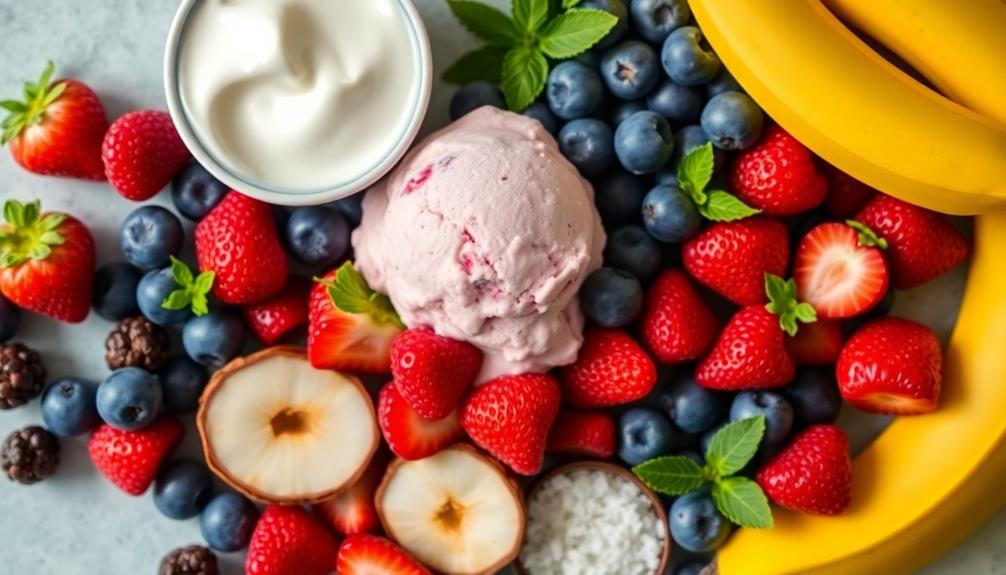
Making low-sugar ice cream requires selecting the right ingredients to guarantee a creamy texture and delicious flavor without compromising your health goals.
Start with a base of full-fat coconut milk or heavy cream; both provide healthy fats that are beneficial for diabetics. If you prefer a lighter option, unsweetened almond milk serves as a low-carb alternative, adding creaminess while reducing overall calories.
Next, incorporate sugar-free powdered sweeteners like allulose or stevia. These sweeteners give you the sweetness you crave without raising blood sugar levels, making them perfect for diabetic-friendly ice cream.
To enhance the texture and richness, consider adding egg yolks; they also contribute a boost of protein.
For flavor, don't forget the essentials: a splash of vanilla extract can elevate your low carb vanilla ice cream, while unsweetened cocoa powder brings a delightful chocolatey twist without unwanted sugars.
With these key ingredients, you're well on your way to creating delicious, low-sugar ice cream that satisfies your sweet tooth while aligning with your dietary needs.
Enjoy the process of experimenting to find your perfect blend!
Simple Preparation Steps
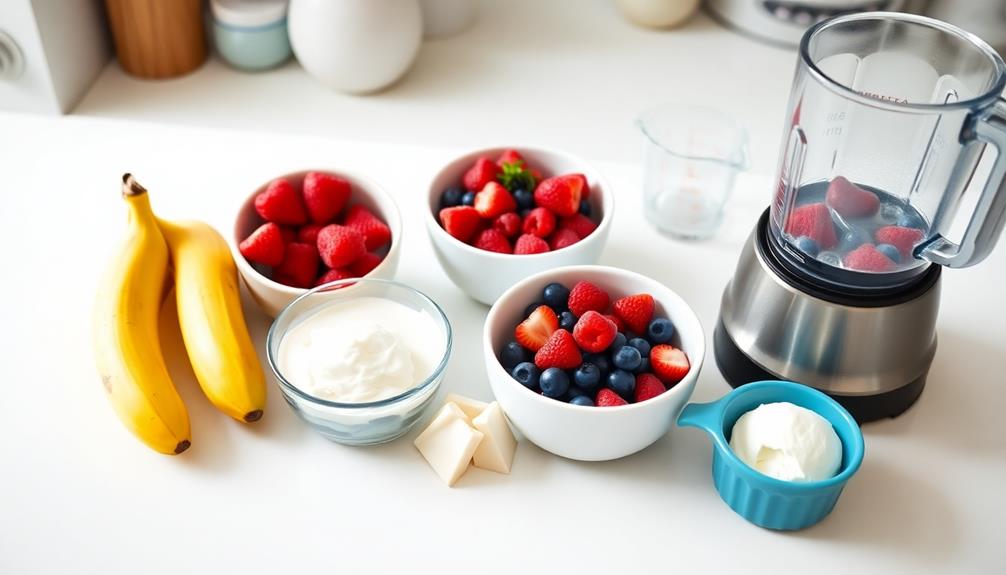
Creating low-sugar ice cream is a straightforward process that begins with chilling your ingredients. Start by refrigerating canned full-fat coconut milk overnight; this will help separate the cream, giving you a rich base for your ice cream made with minimal sugar.
Once chilled, whip the coconut cream until smooth and creamy. In another bowl, whip heavy cream until soft peaks form. Combine both mixtures and add a sugar-free powdered sweetener for sweetness.
For extra flavor, mix in vanilla extract or vanilla bean seeds before folding in the coconut cream. This combination creates a delightful whipped cream mixture that's perfect for your diabetic ice cream.
Next, transfer your combined mixture into a chilled loaf pan, cover it, and freeze for at least 2 hours. This allows the flavors to meld and the texture to firm up.
When you're ready to serve, let the ice cream sit at room temperature for about 10 minutes to make scooping easier.
If you prefer using an ice cream maker, whisk your chosen milk and sweeteners until smooth, then churn according to the manufacturer's instructions for a creamier texture. Enjoy your delicious, low-sugar treat!
Flavor Variations to Explore

Once you've mastered the basic low-sugar ice cream recipe, it's time to have some fun with flavors. You can easily transform your ice cream into a delightful treat by adding a variety of ingredients. Here are some exciting flavor variations to explore:
- Mint Chocolate Chip: Mix in crushed mint leaves or peppermint extract for a revitalizing twist.
- Fruity Bliss: Blend in fresh fruits like ripe strawberries or blueberries for a natural sweetness.
- Peanut Butter Cup: Combine natural sugar-free peanut butter with sugar-free chocolate chips for a rich flavor.
- Gourmet Vanilla: Infuse your base with spices like cinnamon or nutmeg, and add a splash of vanilla extract for sophistication.
You can also try sugar-free caramel for a decadent salted caramel taste or use unsweetened cocoa powder for a rich chocolate flavor.
The possibilities are endless, so don't hesitate to experiment with sugar-free flavor extracts to create your perfect blend. Embrace your creativity, and enjoy the delicious, guilt-free indulgence of your low-sugar ice cream!
Tips for Best Results

For the best results in your low-sugar ice cream endeavor, focus on the right ingredients and techniques. Start with high-fat dairy or dairy alternatives, like heavy cream or coconut milk, to create that creamy texture you crave while keeping sugar content low.
When it comes to sweeteners, opt for allulose or Bocha Sweet to guarantee sweetness without affecting your blood sugar levels. Unlike erythritol, these sugars won't crystallize, making your low sugar ice cream smoother.
Incorporate stabilizers such as xanthan gum to prevent ice crystals from forming and to enhance the overall texture of your homemade ice cream.
Before you begin, chill all equipment, including bowls and containers, to improve the freezing process. This step is essential for achieving a smoother consistency.
As your ice cream freezes, remember to monitor the ice cream closely. Stir every 30 minutes to maintain that creamy texture and prevent hardness.
Following these tips will help you create delicious low-sugar ice cream that's both satisfying and diabetic-friendly. Enjoy experimenting with your ice cream recipes while keeping your health in mind!
Storage and Shelf Life
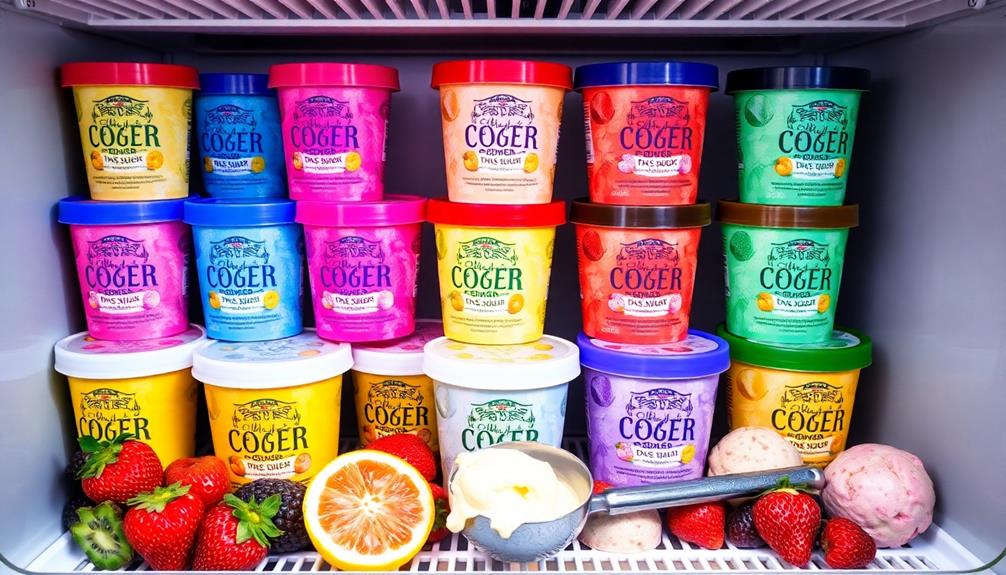
To keep your homemade low-sugar ice cream fresh, store it in airtight containers and label them with the preparation date.
You can enjoy it for up to 2-4 weeks for the best flavor, but if sealed well, it can last in the freezer for up to 6 months.
Just remember to let it soften for 15-20 minutes before serving, and avoid re-freezing more than once for the best texture.
Proper Storage Techniques
Maintaining the freshness of your low-sugar ice cream is essential for enjoying its delightful taste and texture. To achieve ideal freshness and prevent freezer burn, store your ice cream in an airtight container. This not only helps retain the creamy consistency but also keeps the sugar content low and flavors intact.
Here are some tips for proper storage techniques:
- Use airtight containers to minimize air exposure.
- Label your containers with the date of preparation for easy tracking.
- Allow your ice cream to sit at room temperature for 10-15 minutes before serving for that perfect soft serve texture.
- Avoid re-freezing your ice cream more than once to prevent graininess and ice crystal formation.
For extended shelf life, consider vacuum-sealed bags or containers to keep the low-sugar ice cream fresh for up to six months.
Shelf Life Tips
Maximize the shelf life of your low-sugar ice cream by implementing a few simple storage strategies. For ideal freshness, store your sugar-free ice cream in airtight containers, which can help prevent freezer burn and extend its life to about 2-4 weeks. Make sure each container is fully sealed to avoid air exposure, which causes ice crystals that can ruin the texture.
Here's a quick reference for keeping your low-sugar ice cream fresh:
| Storage Tip | Details |
|---|---|
| Use Airtight Containers | Prevents freezer burn and maintains quality. |
| Track Freshness | Label containers with the date of preparation. |
| Softening Tips | Let it sit at room temperature for 10-15 minutes. |
Regularly check the texture during storage. If it gets too hard, soften it, then re-churn to restore creaminess. This method is especially useful for diabetics who want to enjoy their treats without compromising on quality. Following these tips will help you savor your delicious low-sugar ice cream for longer!
Nutritional Information Overview
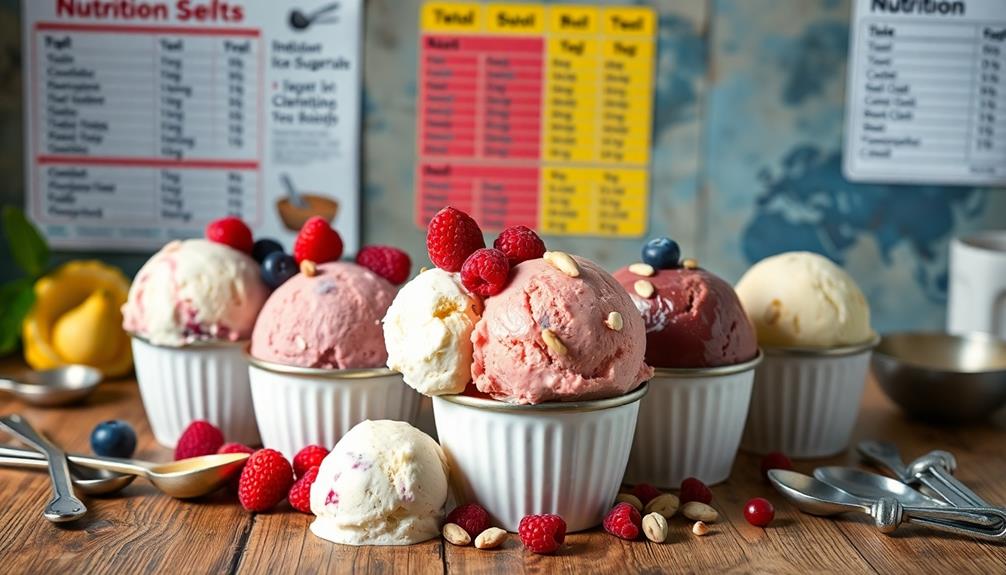
When you're choosing low-sugar ice cream, it's crucial to take into account the caloric content and carb count.
Many options offer a satisfying treat without the guilt, thanks to their low net carbs and calorie range.
Let's highlight the nutritional benefits that make these recipes a great choice for your dessert cravings.
Caloric Content Comparison
While many ice cream lovers crave the rich flavors and creamy textures of traditional treats, low-sugar ice cream recipes offer a healthier alternative without sacrificing taste. When you whip up delicious homemade options, you'll find that the caloric content is markedly lower, making it a fantastic choice for diabetics.
Consider these key points:
- Low-sugar ice cream typically contains around 330 calories per serving, compared to over 500 calories in traditional ice cream.
- Sugar-free ice creams often have a net carb count of just 2-7 grams per serving, while regular options can exceed 20 grams.
- Utilizing low-calorie sweeteners like allulose or stevia keeps sugar content to about 1-2 grams, ideal for those watching their intake.
- Sugar-free varieties usually feature higher fat content, averaging 34-70 grams per serving, which enhances creaminess and satisfaction.
With sources of healthy fats and calcium, these recipes not only satisfy your cravings but also support a balanced diet.
Carb Count Analysis
For those mindful of their carbohydrate intake, low-sugar ice cream recipes offer a rejuvenating option. These recipes typically feature net carbs ranging from 2g to 7g per serving, making them ideal for diabetic diets. By using sweeteners like allulose and stevia, you can greatly reduce sugar without sacrificing sweetness, as allulose boasts zero net carbs.
Incorporating heavy cream or coconut cream not only enhances the creaminess of your low-sugar ice cream but also increases the fat content, which helps in keeping the overall carbohydrate count low. Each serving may contain around 330-672 calories, depending on the ingredients you choose.
This careful balance allows you to enjoy a delicious treat while managing your blood sugar levels effectively. Plus, homemade low-sugar ice cream can still provide essential vitamins and minerals, such as calcium and vitamin A, contributing to a well-rounded diet.
Nutritional Benefits Highlighted
Low-sugar ice cream not only satisfies your sweet tooth but also offers impressive nutritional benefits. For diabetics, this dessert option can be a guilt-free indulgence, allowing you to enjoy a creamy treat without spiking your blood sugar levels. By using sugar-free sweeteners like allulose or stevia, you can keep your net carbs below 10 grams per serving.
Here are some key nutritional benefits of low-sugar ice cream:
- Low Net Carbs: Typically fewer than 10 grams per serving, making it diabetic-friendly.
- Sugar-Free Sweeteners: Minimal impact on blood glucose levels compared to regular sugar.
- High-Fat Ingredients: Coconut cream or heavy cream enhances the creamy texture and aids in appetite control.
- Customization: Homemade recipes let you tailor the nutritional profile to fit your dietary needs.
With around 330 kcal and 34g of fat per serving, low-sugar ice cream can satisfy your cravings while offering a fulfilling dessert experience.
Embrace the delicious world of homemade low-sugar ice cream, and take control of your diet with delightful flavors tailored just for you!
Creative Serving Suggestions

When it comes to serving low-sugar ice cream, creativity can turn a simple dessert into an exciting experience. Start with a delicious homemade sugar-free ice cream mixture, and you've already got a fantastic base.
To elevate your treat, top your ice cream with fresh berries. They not only add natural sweetness but also pack in antioxidants, keeping your dessert healthy.
For a fun twist, set up an ice cream sundae bar! Include options like unsweetened coconut flakes, chopped nuts, and sugar-free chocolate sauce. This way, you can customize your sundae to fit your taste perfectly.
If you're looking for added texture and healthy fats, pair your low-sugar ice cream with keto-friendly granola or crushed nuts.
Another exciting option is to create a revitalizing float. Just add sparkling water or sugar-free soda to your ice cream for a fizzy, delightful treat that's still low in sugar.
With these creative serving suggestions, you can enjoy your low-sugar ice cream in various ways while keeping it fun and satisfying!
Frequently Asked Questions
What Ice Cream Is OK for a Diabetic?
You can enjoy ice cream options that are low in sugar and carbs. Look for products sweetened with stevia or erythritol, or consider making your own with almond milk for a healthier treat.
What Ice Cream Has the Least Amount of Sugar?
When you crave ice cream, you want the ultimate low-sugar delight! Look for "no sugar added" or "sugar-free" labels, which can surprise you with less than 2g of sugar per serving. Enjoy guilt-free!
Can Diabetics Eat Blue Bell No Sugar Added Ice Cream?
Yes, you can eat Blue Bell No Sugar Added ice cream, but be mindful of portion sizes. It's best to consult your healthcare provider to verify it fits your dietary needs and won't spike your blood sugar.
What Frozen Dessert Can Diabetics Eat?
Ever wondered what frozen treats you can enjoy? You can savor sugar-free sorbets or low-carb ice creams made with almond or coconut milk. Just be mindful of toppings; fresh berries add flavor without raising sugar levels!
Conclusion
Incorporating low-sugar ice cream into your diet can feel like discovering a hidden gem in a familiar landscape—unexpected and delightful. Just like finding a cool oasis on a hot summer day, these recipes offer a rejuvenating treat without compromising your health. With the right ingredients and a bit of creativity, you can savor every spoonful guilt-free. So go ahead, indulge your sweet tooth while keeping your blood sugar in check—your taste buds and body will thank you!

